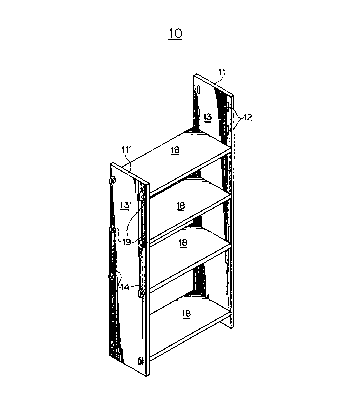Some of the information on this Web page has been provided by external sources. The Government of Canada is not responsible for the accuracy, reliability or currency of the information supplied by external sources. Users wishing to rely upon this information should consult directly with the source of the information. Content provided by external sources is not subject to official languages, privacy and accessibility requirements.
Any discrepancies in the text and image of the Claims and Abstract are due to differing posting times. Text of the Claims and Abstract are posted:
| (12) Patent: | (11) CA 2102737 |
|---|---|
| (54) English Title: | MODULAR SHELVING INTERCONNECTION ASSEMBLY |
| (54) French Title: | ASSEMBLAGE POUR RAYONNAGE MODULAIRE |
| Status: | Expired and beyond the Period of Reversal |
| (51) International Patent Classification (IPC): |
|
|---|---|
| (72) Inventors : |
|
| (73) Owners : |
|
| (71) Applicants : |
|
| (74) Agent: | LAMBERT INTELLECTUAL PROPERTY LAW |
| (74) Associate agent: | |
| (45) Issued: | 1999-08-24 |
| (22) Filed Date: | 1993-11-09 |
| (41) Open to Public Inspection: | 1994-06-10 |
| Examination requested: | 1995-08-18 |
| Availability of licence: | N/A |
| Dedicated to the Public: | N/A |
| (25) Language of filing: | English |
| Patent Cooperation Treaty (PCT): | No |
|---|
| (30) Application Priority Data: | ||||||
|---|---|---|---|---|---|---|
|
ABSTRACT OF THE DISCLOSURE
A modular shelving interconnection assembly is dis-
closed. The assembly has two (2) substantially upright,
spaced-apart side panels with holes extending through
their lateral surfaces at approximately equal distances
from their bottoms. Tabs of shelf support units extend
through the holes in the side panels. Pegs in the shape
of split, truncated cones extend through the holes in the
tab on the outside of the panels, and cooperate with the
holes in the tabs and the outside surface of the panels to
secure the shelf-support units to the panels. The modular
assembly may be repeated in the direction of the shelf
support unit to extend it to a wall-length shelving unit.
Note: Claims are shown in the official language in which they were submitted.
Note: Descriptions are shown in the official language in which they were submitted.

2024-08-01:As part of the Next Generation Patents (NGP) transition, the Canadian Patents Database (CPD) now contains a more detailed Event History, which replicates the Event Log of our new back-office solution.
Please note that "Inactive:" events refers to events no longer in use in our new back-office solution.
For a clearer understanding of the status of the application/patent presented on this page, the site Disclaimer , as well as the definitions for Patent , Event History , Maintenance Fee and Payment History should be consulted.
| Description | Date |
|---|---|
| Revocation of Agent Requirements Determined Compliant | 2020-04-22 |
| Appointment of Agent Requirements Determined Compliant | 2020-04-22 |
| Time Limit for Reversal Expired | 2008-11-10 |
| Letter Sent | 2007-11-09 |
| Inactive: IPC from MCD | 2006-03-11 |
| Inactive: IPC from MCD | 2006-03-11 |
| Grant by Issuance | 1999-08-24 |
| Inactive: Cover page published | 1999-08-23 |
| Inactive: Final fee received | 1999-05-19 |
| Pre-grant | 1999-05-19 |
| Letter Sent | 1999-02-16 |
| Notice of Allowance is Issued | 1999-02-16 |
| Notice of Allowance is Issued | 1999-02-16 |
| Inactive: Approved for allowance (AFA) | 1998-07-13 |
| Inactive: Application prosecuted on TS as of Log entry date | 1997-11-21 |
| Inactive: Status info is complete as of Log entry date | 1997-11-21 |
| All Requirements for Examination Determined Compliant | 1995-08-18 |
| Request for Examination Requirements Determined Compliant | 1995-08-18 |
| Application Published (Open to Public Inspection) | 1994-06-10 |
There is no abandonment history.
The last payment was received on 1999-05-19
Note : If the full payment has not been received on or before the date indicated, a further fee may be required which may be one of the following
Patent fees are adjusted on the 1st of January every year. The amounts above are the current amounts if received by December 31 of the current year.
Please refer to the CIPO
Patent Fees
web page to see all current fee amounts.
| Fee Type | Anniversary Year | Due Date | Paid Date |
|---|---|---|---|
| Request for examination - small | 1995-08-18 | ||
| MF (application, 4th anniv.) - small | 04 | 1997-11-10 | 1997-11-06 |
| MF (application, 5th anniv.) - small | 05 | 1998-11-09 | 1998-10-29 |
| MF (application, 6th anniv.) - small | 06 | 1999-11-09 | 1999-05-19 |
| Final fee - small | 1999-05-19 | ||
| MF (patent, 7th anniv.) - small | 2000-11-09 | 2000-10-25 | |
| MF (patent, 8th anniv.) - small | 2001-11-09 | 2001-11-01 | |
| MF (patent, 9th anniv.) - small | 2002-11-11 | 2002-10-11 | |
| MF (patent, 10th anniv.) - small | 2003-11-10 | 2003-10-24 | |
| MF (patent, 11th anniv.) - small | 2004-11-09 | 2004-10-06 | |
| MF (patent, 12th anniv.) - small | 2005-11-09 | 2005-11-02 | |
| MF (patent, 13th anniv.) - small | 2006-11-09 | 2006-11-01 |
Note: Records showing the ownership history in alphabetical order.
| Current Owners on Record |
|---|
| THOMAS W. GOLLICK |
| Past Owners on Record |
|---|
| None |